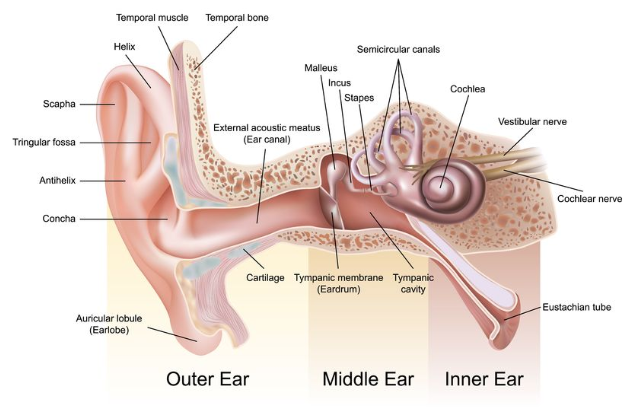Hearing loss: understanding the differences between sensorineural and conductive hearing loss
As an experienced Audiologist, I know that hearing loss can be a complex and confusing topic for many patients to understand the details and causes. There are two main types of hearing loss, sensorineural and conductive, and it is important to understand the differences between the two in order to determine the best course of action for treatment.
Sensorineural Hearing Loss
Sensorineural hearing loss is the most common type of hearing loss, and it occurs when there is damage to the inner ear, specifically the cochlea or the auditory nerve. This type of hearing loss is typically permanent, and it affects the way that sound is processed and transmitted to the brain.
Structures of the ear
Sensorineural hearing loss impacts the inner ear structures.
Symptoms of sensorineural hearing loss can include difficulty hearing in noisy environments, difficulty hearing certain clarity and definition of speech, and tinnitus (ringing in the ears). This type of hearing loss is often caused by age-related changes in the inner ear, exposure to loud noise, and certain medical conditions such as Meniere's disease or ototoxic drug exposure.
Diagnosis of sensorineural hearing loss typically involves a comprehensive hearing evaluation, including a hearing test and a review of the individual's medical history. Depending on the severity of the hearing loss, a referral to an ENT specialist may be necessary for further testing and evaluation.
Treatment options for sensorineural hearing loss can vary depending on the severity and cause of the hearing loss. In many cases, hearing devices can be an effective solution, and they can help to amplify sound and make it easier to hear in challenging environments. In more severe cases, cochlear implantation may be recommended.
Conductive Hearing Loss
Conductive hearing loss occurs when there is a problem with the structures of the outer or middle ear, preventing sound from being effectively transmitted to the inner ear. This type of hearing loss is often temporary, and it can be caused by a variety of factors, including earwax blockage, fluid in the middle ear, or a perforated eardrum.
Structures of the ear
Conductive hearing loss impacts the middle or outer ear structures.
Symptoms of conductive hearing loss can include difficulty hearing in most situations, muffled speech, and tinnitus. In some cases, the patient may also experience pain or discomfort in the affected ear if there is infection.
Diagnosis of conductive hearing loss typically involves a comprehensive hearing evaluation, including a hearing test and a physical examination of the ear. This may involve using an otoscope to examine the ear and assess the structures of the outer and middle ear and tympanometry to test the health and function of the middle ear structures.
Treatment options for conductive hearing loss can vary depending on the cause of the hearing loss. In many cases, the problem can be easily resolved through a simple procedure such as earwax removal with an Ear Nurse. In more complex cases, referral to ENT may be required to assess damage or infection to the eardrum or middle ear bones and surgery may be necessary.
In most cases, a good outcome for both sensorineural and conductive hearing loss involves finding an effective solution for managing the hearing loss and improving the patient's quality of life. For sensorineural hearing loss, this may involve the use of hearing devices or cochlear implantation, and for conductive hearing loss, it may involve a simple procedure such as earwax removal or surgery.
It is also important to take steps to prevent hearing loss, particularly in cases of sensorineural hearing loss. This can involve reducing exposure to loud noise, avoiding ototoxic drugs, and getting regular hearing evaluations to monitor changes in hearing over time.
By seeking professional advice in diagnosing and understanding the differences between sensorineural and conductive hearing loss an experienced Audiologist can determine the best course of action for treatment.
Related reading

